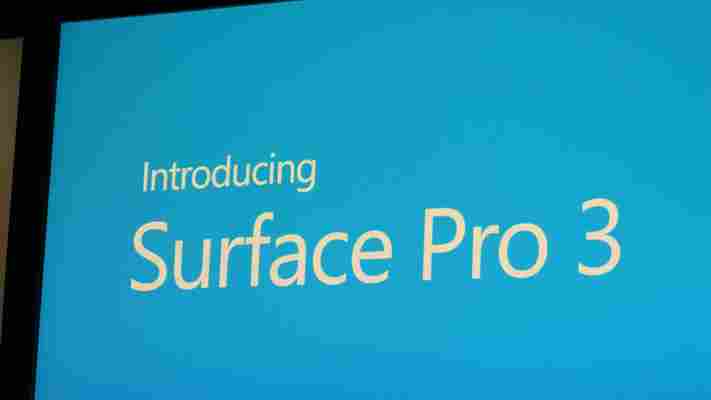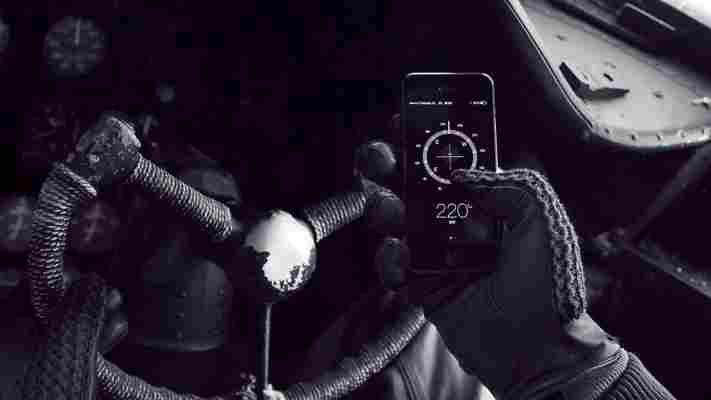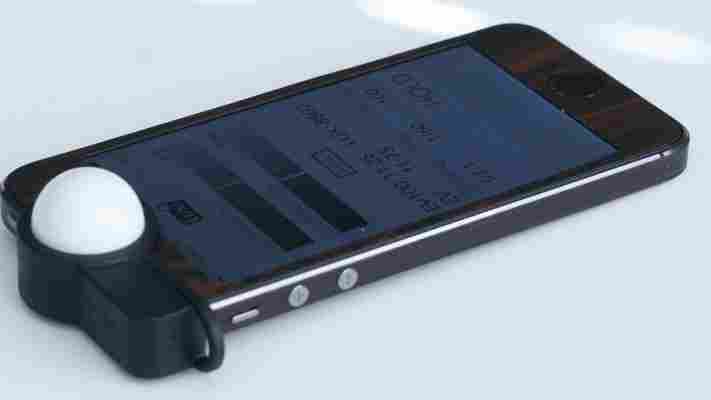At its “ small gathering ” event in New York City today, Microsoft announced the Surface Pro 3. The device has a 12-inch screen with a 2160×1440 resolution, a 3:2 aspect ratio, as well as 4K display support.

The Surface Pro 3 starts at $799 and will be available for preorder tomorrow, with shipping beginning on June 20. You’ll still need to shell out $130 if you want the keyboard though, which means you’re looking at $929 for the cheapest laptop option, and another $49 for the pen.
The full price list is as follows:
Intel Core i3, 64GB and 4GB of RAM: $799.
Intel Core i5, 128GB and 4GB of RAM: $999.
Intel Core i5, 256GB and 8GB of RAM: $1,299.
Intel Core i7, 256GB and 8GB of RAM: $1,549.
Intel Core i7, 512GB and 8GB of RAM: $1,949.
Despite the larger size, the Surface Pro 3 is only 9.1mm (0.358 inches) thick and weighs just 800g (1.76 pounds). Like all Surface devices, it has a multi-position kickstand (up to 150-degree tilt). It also features a stylus pen.
The pen is a big part of the device. When it touches the screen, the device powers on and launches OneNote. You can click the pen to save the content you’ve written directly to OneDrive. Double-clicking it with the camera open will snap a photo and let you write on it via OneNote.
All of this is powered by an Intel Core i3, i5, or i7 processor, depending on which configuration you choose. In fact, Microsoft says this is the thinnest Intel Core product ever made.
“We want to build experiences that bring together all the capabilities of our company,” Microsoft CEO Satya Nadella said on stage prior to the device’s unveiling. “Today is a major milestone on that journey. It starts with dreaming the impossible. Can we design a device that combines the best of a tablet and laptop?”
Clearly Microsoft thinks it has achieved that goal. Or, at least, it is constantly pushing closer and closer towards achieving that goal.
Panos Panay, Corporate Vice President at Microsoft working on Surface, went on for quite a few minutes about how consumers nowadays buy both laptops and tablets. This is a conflict everyone deals with when they enter a store to buy a device. “Today we’re focusing on taking that conflict away,” Panay declared.
It’s worth noting that Microsoft unveiled the Surface 2 and Surface Pro 2 just eight months ago . At the time, the Surface line was reduced to $449 while the Surface Pro remained at $899.
Today, the Surface Pro has been reduced by another $100. It’s still quite an expensive device though, especially once you start adding accessories and extras. Yet as we’ll definitely hear from Microsoft time and time again, this is not just a tablet, or just a laptop; it’s both.
See also – Microsoft unveils new Type Cover for Surface Pro 3: 68% larger trackpad and magnetic sealing mode
Mujjo’s mitts: This company’s taking touchscreen gloves to the next level
Picture the scene. You’re walking down an icy-cold thoroughfare, something akin to Hurricane Harry is swirling around you, then you feel that familiar buzz in your pocket. What do you do? Do you answer the call, and surrender your hands to frost bite? Or do you find a bus shelter to seek some respite from the elements? You could always get yourself some gloves too.

Yes, it may be a first-world dilemma, but it’s a dilemma nonetheless. A quick peruse around your local convenience store may reveal a slew of cheap, touchscreen-compatible gloves – and yes, they work great. But Netherlands-based company Mujjo is going all-out to cater for this market, with a range of premium ( AKA ‘not cheap’ ) gloves geared towards the touchscreen-addled generation.
We’ve previously looked at Mujjo’s range of slick felt and leather cases for iPhones, iPads and Macs , though the company is traditionally better-known for its mobile-centric mitt-warmers. And with winter still strutting its stuff across the northern hemisphere, we thought we’d take a closer look at its latest offerings.
In the knitted realm, you have many options for touchscreen gloves. Indeed, the technology behind them is simple enough – conductive material is woven into the fibers to ensure your hand’s electrical signals have uninterrupted contact with the device. With leather, however, things aren’t quite so simple, hence your options have always been more limited on this front.
Often, leather gloves will have little ‘patches’ sewn onto the fingertips to ensure safe passage of these aforementioned electrical signals. But Mujjo is taking things to the next level with its leather crochet touchscreen gloves . The front of the glove is constructed of Egyptian cotton, while the leathery palm-side of the mitt is made from Ethiopian lambskin – with no ‘patches’ in sight. This in itself isn’t entirely unique, but it’s the combination of style and function here that’s notable.
Mujjo founder Remy Nagelmaeker says the company has integrated nanotechnology into the leather of the gloves to mimic the conductive properties of human skin. And based on our tests, they not only look good, but they work very well too.
The one caveat here is that, well, these puppies will cost you €89.95. So if you’re not one to spend such fortunes on a simple pair of gloves at the best of times, you probably wouldn’t do so here. But then, you’re probably not the target market – plenty of people pay through the nose for extravagance, and these won’t exactly break the bank for many.
Moreover, they do actually ooze quality. The cotton-leather combo works well, and the two-buttoned leather strap that crosses the wrist ensures the howling gales are kept out.
There’s no question these would make for a great gift for someone, but in attempting to be just like a regular pair of gloves, there are downsides. The perfect touchscreen glove would hug your fingers tightly and have minimal surface area – but those also tend to be much thinner, which isn’t the best for proper wintery conditions.
With these Mujjo’s gloves, I found the thickness and surface area meant that typing was often cumbersome (though not impossible), and led to mistakes.
However, there are many situations beyond typing where these would come in handy, so to speak, such as swiping to answer calls, scrolling maps and generally hitting icons and buttons on your screen. Only when pinpoint accuracy is required does it become problematic, and even then I found that predictive text managed to circumvent some of the issues.
Also, there’s the (small) issue of color. Yes, it won’t bother everyone, but the fact these are only available in black may deter some, especially when they’re stumping up so much cash.
If the best part of ninety bucks is a little bit too punchy for you, then Mujjo has also recently launched a cheaper knitted glove, aimed squarely at those in cooler climes.
Costing €29.95, the double-layered touchscreen gloves pretty much do exactly what they say on the box. Mujjo developed these mitts in direct response to requests from customers in places such as Canada, Norway and Russia, and they essentially provide double the insulation of its other cheaper gloves .
This additional layer is made out of wool, and serves as extra insulation. The palm-side of the glove, however, features rubber-like dots which is a nice touch, if you’ll pardon the pun, given that this works well for gripping things, such as handlebars or a steering wheel. As with the leather crochet affairs, these sport a fastener across the wrist too, though only one button.
I actually found these to be better suited to typing than the other pair, and more often than not I was able to easily construct meaningful text messages at the first time of asking, presumably due to the fact these are more tightly aligned with my hands and take up less surface area. Though as with the leather pair, these only come in a single color.
If you’re in the market for a new pair of touchscreen-compatible gloves, either of these will serve you well, but it will depend on what you’re really after and what your budget is. The leather crochet incarnations instinctively feel more like the sort of thing you’d buy as a present for someone else, while the double-layered mitts would serve anyone who lives in a cold climate well.
On the other hand, if you’re not a fashionista and don’t live in sub-zero conditions, you could just spend five bucks on a pair from your local convenience store.
➤ Leather Crochet Touchscreen Gloves [ €89.95 ] | Double-Layered Touchscreen Gloves [ €29.95 ]
Luxi turns your iPhone into an incident light meter
If you want to take your photography up a notch without spending big bucks, the $29.95 Luxi attachment for your iPhone can help. It’s a small dome that slides over the front-facing camera in order to turn it into an incident light meter.

Professional photographers likely already have a standalone light meter, which can cost hundreds of dollars, but Luxi gets you started at a fraction of the cost and without having to carry around another bulky device.
Incident light meters work by measuring how much light a subject receives, rather than how much it reflects. Holding the meter up to your subject provides you with suggested camera settings to properly expose the shot.
Luxi, which comes in iPhone 4/4s and iPhone 5/5s, models pairs with an accompanying iPhone app to show you readings. You can also use any other light meter apps that rely on the front camera, but not all of them have been specifically designed with Luxi in mind.
Based on our limited tests, the meter is accurate. If you’re having trouble, you can calibrate the meter to your camera by measuring its readings against your camera’s auto settings and adjusting sliders from within the Luxi app.
Luxi probably isn’t going to replace the dedicated light meters found in serious photographers’ kits, but it’s a convenient accessory that puts the device you already own to work for you.
➤ Luxi [Extrasensory Devices]
